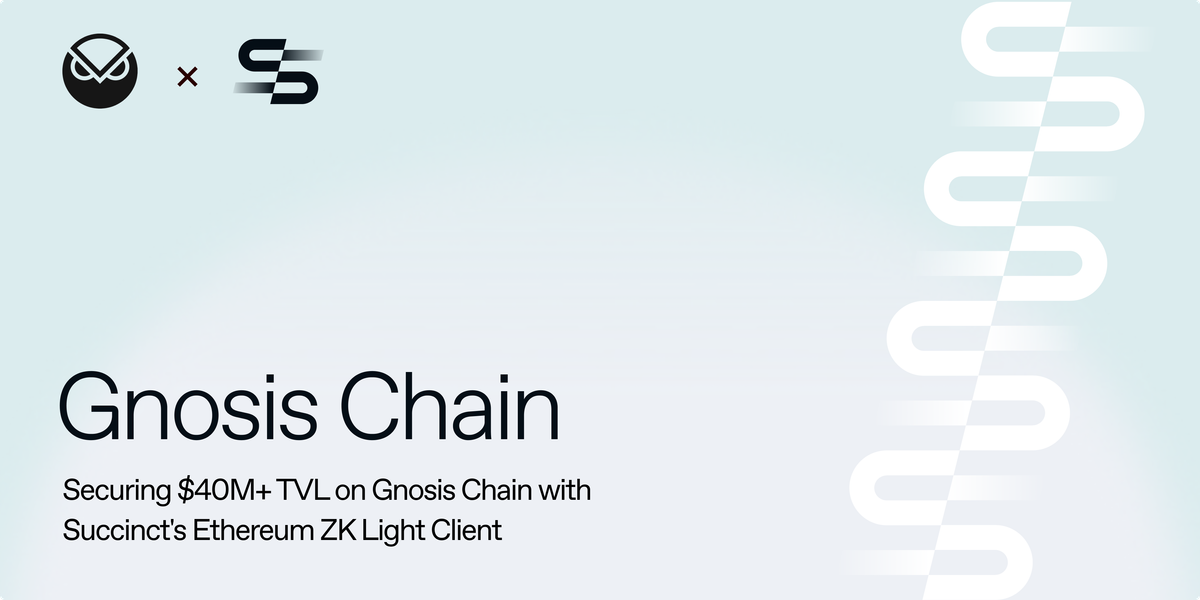Securing $40M+ TVL on Gnosis Chain with Succinct's Ethereum ZK Light Client

Eight months ago, we announced our first demo application that uses our implementation of "proof of consensus" for Ethereum: a bi-directional bridge between Goerli testnet and Gnosis Chain.
Today, after close collaboration with the Gnosis core development team, we are thrilled to share that our Ethereum ZK light client has officially been integrated to secure the Gnosis Omnibridge on Mainnet! As of July 2nd, 2023, the Gnosis Governors cast their votes, adding the Succinct Validator Smart Contract to the roster of eight validators.
With this addition, Succinct's ZK Proof of Consensus for Ethereum is responsible for securing the Gnosis Omnibridge, with over $40M TVL and >$1.5B in stablecoin asset flow to date.
What does this mean for users?

Users can now feel more confident about bridging their assets to the Gnosis ecosystem. Before, the Gnosis bridge was secured by a 5/7 multisig of validators. Now, users who bridge assets or data from Ethereum to Gnosis Chain will now have additional security from our Omnibridge ZK Validator Smart Contract. Our validator relies on our on-chain light client to get Ethereum state and verify whether messages were sent on Ethereum. As a result, the Succinct validator borrows security from Ethereum consensus itself.
With the increase in bridge hacks over the recent years, the security of bridging solutions has never been more important. Our unique approach with Gnosis Chain integrates the robustness of battle-tested validators with the extra layer of protection offered by our ZK light client.
How we were able to integrate seamlessly with the existing Omnibridge

In this section, we will dive deeper into the technical architecture of the system and how we were able to integrate with zero lines of code changed in the core Omnibridge contracts.
End-to-end messaging flow.
When a user sends funds to a contract that uses the Omnibridge to send a message from Ethereum to Gnosis Chain, an event called UserRequestForAffirmation is emitted from the ForeignAMB smart contract on Ethereum. Normally, the validators of the Omnibridge listen to this event and they each called executeAffirmation() on the HomeAMB smart contract that is deployed on Gnosis Chain. Once enough affirmations have been collected, the message automatically gets relayed.
Light client-based validation.
Once the event is emitted, after ~12 minutes the transaction will be reflected finalized block. Then, Succinct generates a zkSNARK which proves the finalized header and submits it on Gnosis Chain to be verified by our Telepathy Light Client contract.
Once the header is available on Gnosis Chain, it suffices to use Merkle proofs to prove the inclusion of the original UserRequestForAffirmation event in the header.
Proving inclusion of the UserRequestForAffirmation event in the Ethereum header
Once an inclusion proof has been provided for the Event, our smart contract validator calls executeAffirmation on the HomeAMB contract!
Try it out!
At Succinct, we believe that the next era of cross-chain bridging between different L1 blockchain ecosystems will be powered by ZK light clients. We are excited to see that our thesis is being adopted in production with our zero-knowledge proof technology being used to secure tens of millions of dollars.
If you love zero-knowledge proofs and bridges, go try out the Omnibridge and bridge to Gnosis Chain!
- Omnibridge: https://omnibridge.gnosischain.com/bridge
- ZK Validator Docs: https://hackmd.io/@succinctlabs/rywE5pam2?type=view
- Open Source Repo: https://github.com/succinctlabs/telepathy-contracts

